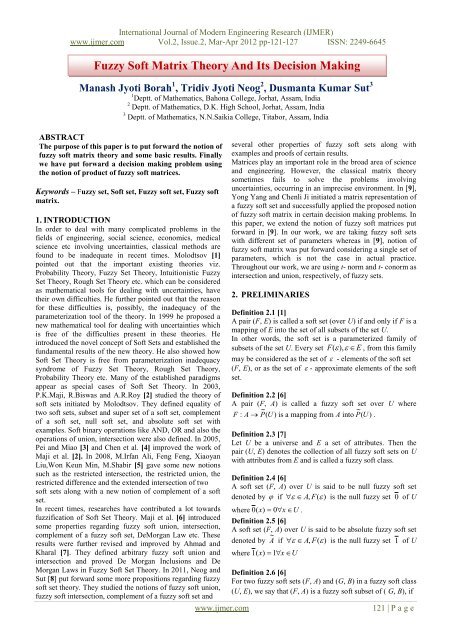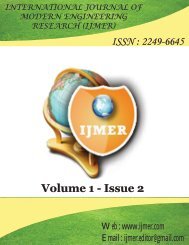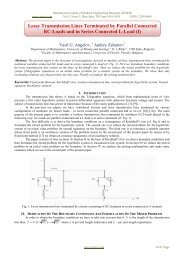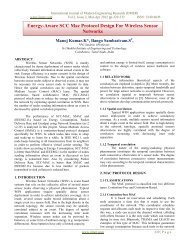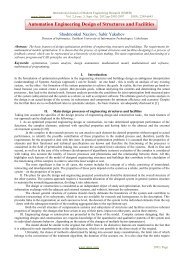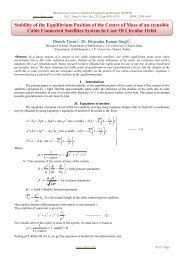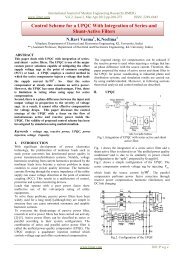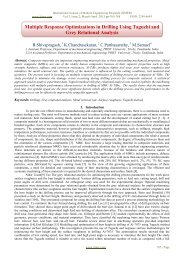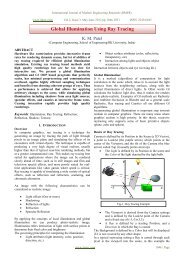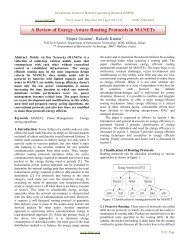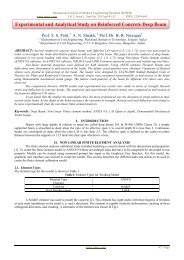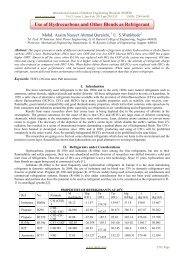Fuzzy Soft Matrix Theory And Its Decision Making - ijmer
Fuzzy Soft Matrix Theory And Its Decision Making - ijmer
Fuzzy Soft Matrix Theory And Its Decision Making - ijmer
Create successful ePaper yourself
Turn your PDF publications into a flip-book with our unique Google optimized e-Paper software.
International Journal of Modern Engineering Research (IJMER)<br />
www.<strong>ijmer</strong>.com Vol.2, Issue.2, Mar-Apr 2012 pp-121-127 ISSN: 2249-6645<br />
<strong>Fuzzy</strong> <strong>Soft</strong> <strong>Matrix</strong> <strong>Theory</strong> <strong>And</strong> <strong>Its</strong> <strong>Decision</strong> <strong>Making</strong><br />
Manash Jyoti Borah 1 , Tridiv Jyoti Neog 2 , Dusmanta Kumar Sut 3<br />
1 Deptt. of Mathematics, Bahona College, Jorhat, Assam, India<br />
2 Deptt. of Mathematics, D.K. High School, Jorhat, Assam, India<br />
3 Deptt. of Mathematics, N.N.Saikia College, Titabor, Assam, India<br />
ABSTRACT<br />
The purpose of this paper is to put forward the notion of<br />
fuzzy soft matrix theory and some basic results. Finally<br />
we have put forward a decision making problem using<br />
the notion of product of fuzzy soft matrices.<br />
Keywords – <strong>Fuzzy</strong> set, <strong>Soft</strong> set, <strong>Fuzzy</strong> soft set, <strong>Fuzzy</strong> soft<br />
matrix.<br />
1. INTRODUCTION<br />
In order to deal with many complicated problems in the<br />
fields of engineering, social science, economics, medical<br />
science etc involving uncertainties, classical methods are<br />
found to be inadequate in recent times. Molodtsov [1]<br />
pointed out that the important existing theories viz.<br />
Probability <strong>Theory</strong>, <strong>Fuzzy</strong> Set <strong>Theory</strong>, Intuitionistic <strong>Fuzzy</strong><br />
Set <strong>Theory</strong>, Rough Set <strong>Theory</strong> etc. which can be considered<br />
as mathematical tools for dealing with uncertainties, have<br />
their own difficulties. He further pointed out that the reason<br />
for these difficulties is, possibly, the inadequacy of the<br />
parameterization tool of the theory. In 1999 he proposed a<br />
new mathematical tool for dealing with uncertainties which<br />
is free of the difficulties present in these theories. He<br />
introduced the novel concept of <strong>Soft</strong> Sets and established the<br />
fundamental results of the new theory. He also showed how<br />
<strong>Soft</strong> Set <strong>Theory</strong> is free from parameterization inadequacy<br />
syndrome of <strong>Fuzzy</strong> Set <strong>Theory</strong>, Rough Set <strong>Theory</strong>,<br />
Probability <strong>Theory</strong> etc. Many of the established paradigms<br />
appear as special cases of <strong>Soft</strong> Set <strong>Theory</strong>. In 2003,<br />
P.K.Maji, R.Biswas and A.R.Roy [2] studied the theory of<br />
soft sets initiated by Molodtsov. They defined equality of<br />
two soft sets, subset and super set of a soft set, complement<br />
of a soft set, null soft set, and absolute soft set with<br />
examples. <strong>Soft</strong> binary operations like AND, OR and also the<br />
operations of union, intersection were also defined. In 2005,<br />
Pei and Miao [3] and Chen et al. [4] improved the work of<br />
Maji et al. [2]. In 2008, M.Irfan Ali, Feng Feng, Xiaoyan<br />
Liu,Won Keun Min, M.Shabir [5] gave some new notions<br />
such as the restricted intersection, the restricted union, the<br />
restricted difference and the extended intersection of two<br />
soft sets along with a new notion of complement of a soft<br />
set.<br />
In recent times, researches have contributed a lot towards<br />
fuzzification of <strong>Soft</strong> Set <strong>Theory</strong>. Maji et al. [6] introduced<br />
some properties regarding fuzzy soft union, intersection,<br />
complement of a fuzzy soft set, DeMorgan Law etc. These<br />
results were further revised and improved by Ahmad and<br />
Kharal [7]. They defined arbitrary fuzzy soft union and<br />
intersection and proved De Morgan Inclusions and De<br />
Morgan Laws in <strong>Fuzzy</strong> <strong>Soft</strong> Set <strong>Theory</strong>. In 2011, Neog and<br />
Sut [8] put forward some more propositions regarding fuzzy<br />
soft set theory. They studied the notions of fuzzy soft union,<br />
fuzzy soft intersection, complement of a fuzzy soft set and<br />
www.<strong>ijmer</strong>.com<br />
several other properties of fuzzy soft sets along with<br />
examples and proofs of certain results.<br />
Matrices play an important role in the broad area of science<br />
and engineering. However, the classical matrix theory<br />
sometimes fails to solve the problems involving<br />
uncertainties, occurring in an imprecise environment. In [9],<br />
Yong Yang and Chenli Ji initiated a matrix representation of<br />
a fuzzy soft set and successfully applied the proposed notion<br />
of fuzzy soft matrix in certain decision making problems. In<br />
this paper, we extend the notion of fuzzy soft matrices put<br />
forward in [9]. In our work, we are taking fuzzy soft sets<br />
with different set of parameters whereas in [9], notion of<br />
fuzzy soft matrix was put forward considering a single set of<br />
parameters, which is not the case in actual practice.<br />
Throughout our work, we are using t- norm and t- conorm as<br />
intersection and union, respectively, of fuzzy sets.<br />
2. PRELIMINARIES<br />
Definition 2.1 [1]<br />
A pair (F, E) is called a soft set (over U) if and only if F is a<br />
mapping of E into the set of all subsets of the set U.<br />
In other words, the soft set is a parameterized family of<br />
subsets of the set U. Every set F( ), E<br />
, from this family<br />
may be considered as the set of - elements of the soft set<br />
(F, E), or as the set of - approximate elements of the soft<br />
set.<br />
Definition 2.2 [6]<br />
A pair (F, ~<br />
A) is called a fuzzy soft set over U where<br />
~<br />
F : A P(<br />
U)<br />
is a mapping from A into P ( U ) .<br />
Definition 2.3 [7]<br />
Let U be a universe and E a set of attributes. Then the<br />
pair (U, E) denotes the collection of all fuzzy soft sets on U<br />
with attributes from E and is called a fuzzy soft class.<br />
Definition 2.4 [6]<br />
A soft set (F, A) over U is said to be null fuzzy soft set<br />
denoted by if A, F(<br />
)<br />
is the null fuzzy set 0 of U<br />
where 0 ( x)<br />
0x<br />
U<br />
.<br />
Definition 2.5 [6]<br />
A soft set (F, A) over U is said to be absolute fuzzy soft set<br />
denoted by A ~ if A, F(<br />
)<br />
is the null fuzzy set 1 of U<br />
where 1( x)<br />
1x<br />
U<br />
Definition 2.6 [6]<br />
For two fuzzy soft sets (F, A) and (G, B) in a fuzzy soft class<br />
(U, E), we say that (F, A) is a fuzzy soft subset of ( G, B), if<br />
121 | P a g e
(i)<br />
A B<br />
International Journal of Modern Engineering Research (IJMER)<br />
www.<strong>ijmer</strong>.com Vol.2, Issue.2, Mar-Apr 2012 pp-121-127 ISSN: 2249-6645<br />
(ii) For all A, F G<br />
and is written as<br />
(F , A) ~ (G, B).<br />
Definition 2.13 [9]<br />
Let A a ij B b <br />
mn<br />
ij be two fuzzy soft matrix .Then<br />
,<br />
mn<br />
A is a fuzzy soft sub matrix of B, denoted by A ~ B , if<br />
a b ,i<br />
j ,<br />
ij ij ,<br />
Definition 2.7 [6]<br />
Union of two fuzzy soft sets (F, A) and (G, B) in a soft class<br />
(U, E) is a fuzzy soft set (H, C) where C AB<br />
and C<br />
,<br />
F(<br />
),<br />
if A B<br />
<br />
H(<br />
) G(<br />
),<br />
if B A<br />
<br />
F(<br />
) G(<br />
), if A B<br />
F , A <br />
~<br />
G,<br />
B H,<br />
C .<br />
<strong>And</strong> is written as <br />
Definition 2.8 [6]<br />
Intersection of two fuzzy soft sets (F, A) and (G, B) in a soft<br />
class (U, E) is a fuzzy soft set (H, C) where C AB<br />
and<br />
C , H( )<br />
F(<br />
)<br />
or G(<br />
)<br />
(as both are same fuzzy<br />
F , A <br />
~<br />
G,<br />
B H,<br />
C .<br />
set) and is written as <br />
Ahmad and Kharal [7] pointed out that generally F(<br />
) or<br />
G()<br />
may not be identical. Moreover in order to avoid the<br />
degenerate case, he proposed that A B must be non-empty<br />
and thus revised the above definition as follows -<br />
Definition 2.9 [7]<br />
Let (F, A) and (G, B) be two fuzzy soft sets in a soft class<br />
(U, E) with A B .Then Intersection of two fuzzy soft<br />
sets (F, A) and (G, B) in a soft class (U, E) is a fuzzy soft set<br />
(H,C) where C AB<br />
and C<br />
,<br />
H( )<br />
F(<br />
)<br />
G(<br />
)<br />
.<br />
F , A <br />
~<br />
G,<br />
B H,<br />
C .<br />
We write <br />
Definition 2.10 [10]<br />
The complement of a fuzzy soft set (F, A) is denoted by<br />
(F, A) c and is defined by (F, A) c = (F c , A) where<br />
F c : A P<br />
~ ( U ) is a mapping given by F c ( )<br />
F<br />
( )<br />
c ,<br />
A.<br />
Definition 2.11 [11]<br />
A binary operation *:[0,1]<br />
[0,1] [0,1<br />
] is continuous t -<br />
norm if * satisfies the following conditions.<br />
(i) * is commutative and associative<br />
(ii) * is continuous<br />
(iii) a * 1= a a [0,1 ]<br />
(iv) a * b c*<br />
d whenever a c, b d and a , b,<br />
c,<br />
d [0,1<br />
]<br />
An example of continuous t - norm is a * b = ab.<br />
Definition 2.12 [11]<br />
A binary operation :[0,1]<br />
[0,1]<br />
[0,1<br />
] is continuous t -<br />
conorm if satisfies the following conditions:<br />
(i) is commutative and associative<br />
(ii) is continuous<br />
(iii) a 0 = a a [0,1 ]<br />
(iv) a b cd<br />
whenever a c, b d and a , b,<br />
c,<br />
d [0,1<br />
]<br />
An example of continuous t - conorm is a * b = a + b – ab.<br />
Definition 2.14 [9]<br />
The m n fuzzy soft matrix whose elements are all 0 is<br />
called the fuzzy soft null matrix (or zero matrix). It is<br />
~ ~<br />
usually denoted by 0 or<br />
0 m n<br />
Definition 2.15 [9]<br />
The m n fuzzy soft matrix whose elements are all 1 is<br />
called the fuzzy universal soft matrix. It is usually denoted<br />
by U ~ or<br />
~<br />
U<br />
m n<br />
Definition 2.16 [9]<br />
Let A a ij B b <br />
mn<br />
ij be two fuzzy soft matrix .Then<br />
,<br />
mn<br />
A is equal to fuzzy soft matrix B, denoted by A B , if<br />
a b ,i<br />
j ,<br />
ij ij ,<br />
Definition2.12 [9]<br />
Let A a ij <br />
FSM m n<br />
. Then we define<br />
A<br />
~<br />
T<br />
~<br />
T<br />
ij<br />
nm<br />
~<br />
T<br />
ij<br />
[ a ] FSM , where a a .<br />
Definition2.13 [9]<br />
Let Ak FSMm n, k 1,2,3 ,......., l , their product is<br />
l<br />
k<br />
1<br />
O<br />
s<br />
A k [ c i ] ml<br />
. Then the set<br />
{ j : c max{ c : i 1,2,3,.....,<br />
m}}<br />
is called the<br />
j<br />
i<br />
optimum subscript set, and the set<br />
O u : u U.<br />
and.<br />
j O<br />
} is called the optimum<br />
d<br />
{ j j<br />
s<br />
decision set of U.<br />
3. FUZZY SOFT MATRICES<br />
Definition 3.1<br />
Let U c , c , c ,...................<br />
c } be the universal set and E<br />
{ 1 2 3<br />
m<br />
be the set of parameters given<br />
by E { e1,<br />
e2,<br />
e3,.........<br />
...........<br />
en}<br />
. Let A E and F, A<br />
be<br />
a fuzzy soft set in the fuzzy soft class U, E<br />
.Then we<br />
would represent the fuzzy soft set F, A<br />
in matrix form as<br />
Amn<br />
[ aij<br />
] mn<br />
or simply by A [ a ij ] ,<br />
i = 1,2,3…………..m ; j = 1,2,3……………..n ,<br />
where a<br />
ij<br />
<br />
j ( ci<br />
)<br />
<br />
<br />
0<br />
if<br />
if<br />
e<br />
e<br />
j<br />
j<br />
ji<br />
A<br />
A<br />
Here j ( c i ) represents the membership of c i in the fuzzy<br />
set F e ) . We would identify a fuzzy soft set with its fuzzy<br />
( j<br />
soft matrix and use these two concepts interchangeable. The<br />
set of all m n fuzzy soft matrices over U would be denoted<br />
by FSM .<br />
m n<br />
www.<strong>ijmer</strong>.com<br />
122 | P a g e
International Journal of Modern Engineering Research (IJMER)<br />
www.<strong>ijmer</strong>.com Vol.2, Issue.2, Mar-Apr 2012 pp-121-127 ISSN: 2249-6645<br />
Example 3.1<br />
Let U c , c , c , } be the universal set and E be the set<br />
{ 1 2 3 c4<br />
of parameters given by E e , e , e , e , } .<br />
{ 1 2 3 4 e5<br />
Let P e<br />
1 , e2,<br />
e4<br />
E and F, P<br />
is the fuzzy soft set<br />
F, P<br />
F( e1 ) c1,0.7 ,<br />
c2<br />
,0.6 ,<br />
c3<br />
,0.7 ,<br />
c4<br />
,0.5<br />
,<br />
F( e2)<br />
c1,0.8 ,<br />
c2<br />
,0.6 ,<br />
c3<br />
,0.1 ,<br />
c4<br />
,0.5,<br />
F e ) c ,0.1 ,<br />
c<br />
,0.4 ,<br />
c<br />
,0.7 ,<br />
,0.3<br />
( 4 1 2 3 c4<br />
The fuzzy soft matrix representing this fuzzy soft set would<br />
be represented in our notation as<br />
0.7<br />
<br />
0.6<br />
A <br />
0.7<br />
<br />
0.5<br />
0.8<br />
0.6<br />
0.1<br />
0.5<br />
0.0<br />
0.0<br />
0.0<br />
0.0<br />
0.1<br />
0.4<br />
0.7<br />
0.3<br />
Proposition 3.1<br />
Let A a ij B b <br />
mn<br />
ij C <br />
,<br />
mn<br />
,<br />
matrix. Then<br />
~<br />
( i)<br />
0 ~ A<br />
~<br />
( ii)<br />
A <br />
~<br />
U<br />
( iii)<br />
A ~ A<br />
( iv)<br />
A <br />
~<br />
B,<br />
B ~ C A ~ C<br />
0.0<br />
0.0<br />
<br />
<br />
0.0<br />
<br />
0.0<br />
c ij m<br />
n<br />
45<br />
be three fuzzy soft<br />
Definition 3.7<br />
Let<br />
A [ a ij ] FSM , where a ij j ( c i ) . Then A is<br />
m n<br />
called fuzzy soft scalar matrix if m = n, a 0 for<br />
all i j and 0,1 i j .<br />
a ij<br />
Definition 3.8<br />
Let<br />
A [ a ij ] FSM , where a ij j ( c i ) . Then A is<br />
m n<br />
called fuzzy soft upper triangular matrix if m = n, a 0<br />
for all<br />
i j .<br />
Definition 3.9<br />
Let<br />
A [ a ij ] FSM , where a ij j ( c i ) . Then A is<br />
m n<br />
called fuzzy soft lower triangular matrix if m = n, a 0<br />
for all i j .<br />
A fuzzy soft matrix is said to be triangular if it is either<br />
fuzzy soft lower or fuzzy soft upper triangular matrix.<br />
Definition 3.10<br />
Let A [ a ij ] FSM , where a ij j ( c i ) , then the<br />
elements<br />
m m<br />
a , a12,.........<br />
..., a<br />
11 mm are called the diagonal<br />
elements and the line along which they lie is called the<br />
principal diagonal of the fuzzy soft matrix.<br />
ij<br />
ij<br />
ij<br />
Proof: The proof is straight forward and follows from<br />
definition.<br />
Definition 3.2<br />
Let A [ a ij ] FSM , where a ij j ( c i ) . If n<br />
m n<br />
then A is called a fuzzy soft rectangular matrix.<br />
m ,<br />
Definition 3.3<br />
Let A [ a ij ] FSM , where a ij j ( c i ) . If m = n, then<br />
m n<br />
A is called a fuzzy soft square matrix.<br />
Definition 3.4<br />
Let A [ a ij ] FSM , where a ij j ( c i ) . If m = 1, then<br />
m n<br />
A is called a fuzzy soft row matrix.<br />
Definition 3.5<br />
Let A [ a ij ] FSM , where a ij j ( c i ) . If n = 1, then<br />
m n<br />
A is called a fuzzy soft column matrix.<br />
Definition 3.6<br />
Let<br />
A [ a ij ] FSM , where a ij j ( c i ) . Then A is<br />
m n<br />
called fuzzy soft diagonal matrix if m = n and a 0 for<br />
all i j .<br />
ij<br />
Definition 3.11<br />
Let A a<br />
ij , B b<br />
ij <br />
FSMmn<br />
. Then union of A, B is<br />
defined by A <br />
~<br />
B C [<br />
c ] , where<br />
c<br />
ij<br />
ij<br />
ij<br />
mn<br />
ij<br />
mn<br />
ij<br />
ij<br />
mn<br />
ij<br />
ij mn<br />
a b<br />
a b a b for all i and j.<br />
Example 3.2<br />
0.1<br />
0.2 0.3<br />
<br />
Let A <br />
<br />
<br />
0.2 0.5 0.7<br />
<br />
and<br />
<br />
0.0 1.0 0.3<br />
Then<br />
0.5<br />
0.2 0.6<br />
B <br />
<br />
<br />
<br />
0.1 0.3 0.2<br />
<br />
.<br />
<br />
0.2 0.7 0.0<br />
0.55<br />
0.36 0.72<br />
A <br />
~<br />
<br />
<br />
<br />
33<br />
B33<br />
C33<br />
<br />
0.28 0.65 0.76<br />
<br />
<br />
0.20 1.00 0.30<br />
Definition 3.12<br />
Let A a<br />
ij , B b<br />
ij <br />
FSMmn<br />
Then intersection of A, B is<br />
defined by A <br />
~<br />
B C [ c ] , where<br />
cij<br />
a<br />
ij<br />
ij<br />
mn<br />
ij<br />
ij<br />
mn<br />
mn<br />
* b a b for all i and j.<br />
ij mn<br />
Example 3.3<br />
For the fuzzy soft matrices cited in example 3.2, we have<br />
A <br />
~<br />
33<br />
B33<br />
C<br />
33<br />
0.05<br />
<br />
<br />
<br />
0.02<br />
<br />
0.00<br />
0.04<br />
0.15<br />
0.70<br />
0.18<br />
0.14<br />
<br />
<br />
0.00<br />
www.<strong>ijmer</strong>.com<br />
123 | P a g e
International Journal of Modern Engineering Research (IJMER)<br />
www.<strong>ijmer</strong>.com Vol.2, Issue.2, Mar-Apr 2012 pp-121-127 ISSN: 2249-6645<br />
Proposition 3.2<br />
~<br />
( ii)<br />
A <br />
~<br />
U a<br />
ij 1 a<br />
ij <br />
A<br />
Let A, B<br />
FSM m n<br />
.Then<br />
(i) A <br />
~ ~<br />
( iii)<br />
A ~ B a ij b ij <br />
0 A<br />
~ ~<br />
(ii) A <br />
~<br />
b ij a ij <br />
U U<br />
(iii) A<br />
~<br />
B B <br />
~<br />
A<br />
B ~ A<br />
A <br />
~<br />
B <br />
~<br />
C A <br />
~<br />
B <br />
~<br />
C<br />
(iv) <br />
Proof: Let A a ij B<br />
mn<br />
,<br />
fuzzy soft matrices .<br />
~<br />
( ) A <br />
~<br />
0 a 0 a<br />
b ij , C c <br />
mn<br />
ij mn<br />
i o<br />
a<br />
<br />
A<br />
~<br />
ii)<br />
A<br />
~<br />
U<br />
iii)<br />
A ~ B<br />
( a<br />
ij 1<br />
aij<br />
1 1<br />
U<br />
( a<br />
ij bij<br />
aij<br />
bij<br />
<br />
b<br />
a b a <br />
ij<br />
ij<br />
ij<br />
B ~ A<br />
a b<br />
( iv)<br />
A<br />
~ B<br />
~ C a b <br />
~<br />
c<br />
<br />
A<br />
<br />
<br />
ij<br />
ij<br />
ij<br />
ij<br />
ij<br />
ij<br />
ij<br />
ij<br />
be three<br />
~<br />
a<br />
ij bij<br />
aij<br />
bij<br />
<br />
cij<br />
a<br />
ij bij<br />
aij<br />
bij<br />
c<br />
ij <br />
a<br />
b c a b<br />
<br />
ij<br />
a<br />
ij<br />
ij<br />
c<br />
ij<br />
ij<br />
b<br />
ij<br />
c<br />
ij<br />
ij<br />
ij<br />
a<br />
~ B<br />
<br />
~ C<br />
a <br />
~<br />
b c b c<br />
<br />
Hence<br />
Remark<br />
A<br />
<br />
a<br />
ij<br />
ij<br />
a<br />
<br />
a<br />
ij<br />
ij<br />
<br />
b<br />
<br />
ij<br />
ij<br />
b<br />
b<br />
ij<br />
c<br />
ij<br />
ij<br />
ij<br />
c<br />
c<br />
ij<br />
ij<br />
b<br />
ij<br />
ij<br />
b<br />
a<br />
aij<br />
cij<br />
bij<br />
cij<br />
<br />
~<br />
C A <br />
~<br />
B <br />
~<br />
C<br />
A<br />
<br />
~<br />
B .<br />
Let a ij , B b <br />
mn<br />
ij mn<br />
If we consider C<br />
mn<br />
where c maxa<br />
, b <br />
ij<br />
ij<br />
ij<br />
ij<br />
c<br />
ij<br />
ij<br />
ij<br />
ij<br />
c<br />
b<br />
ij<br />
a<br />
ij<br />
b<br />
<br />
<br />
ij<br />
ij<br />
b<br />
ij<br />
c<br />
ij<br />
c<br />
be two fuzzy soft matrices.<br />
A <br />
~<br />
B [<br />
c ] ,<br />
ij<br />
mn<br />
mn<br />
ij mn<br />
, for all i and j, then A ~ A<br />
A .<br />
Proposition 3.3<br />
Let A, BFSM m n<br />
.Then<br />
(i) A <br />
~ ~ 0 A<br />
(ii) A <br />
~<br />
U<br />
~ A<br />
(iii) A<br />
~<br />
B B <br />
~<br />
A<br />
A <br />
~<br />
B <br />
~<br />
C A <br />
~<br />
(iv) B<br />
<br />
~<br />
C<br />
Proof: Let A a ij B b<br />
mn<br />
ij<br />
,<br />
fuzzy soft matrices, for all i and j.<br />
~<br />
( ) A <br />
~<br />
0<br />
i o<br />
0 <br />
~ 0<br />
a ij<br />
, C c <br />
mn<br />
ij mn<br />
be three<br />
ij<br />
<br />
<br />
A<br />
~ B ~ C<br />
( iv)<br />
a<br />
b <br />
~<br />
c<br />
<br />
Remark<br />
A<br />
<br />
<br />
ij<br />
ij<br />
ij<br />
a<br />
ij bij<br />
<br />
cij<br />
<br />
a<br />
ij b<br />
ij cij<br />
<br />
a<br />
<br />
~<br />
b<br />
c <br />
ij<br />
A <br />
~<br />
Let a ij , B b <br />
mn<br />
ij mn<br />
we consider C<br />
ij<br />
<br />
ij<br />
mn<br />
ij<br />
<br />
<br />
ij<br />
B <br />
~<br />
C<br />
<br />
ij<br />
be two fuzzy soft matrices. If<br />
A <br />
~<br />
B [ c ] , where<br />
mn<br />
mn<br />
ij mn<br />
c min a , b , for all i and j, then A ~ A<br />
A .<br />
Definition 3.13<br />
Let A , then complement of A is denoted<br />
a ij mn<br />
C<br />
by c<br />
<br />
1<br />
a<br />
A ij , where ij ij<br />
Example 3.4<br />
Let A<br />
Then<br />
C<br />
A<br />
0.9<br />
<br />
<br />
<br />
0.8<br />
<br />
1.0<br />
0.1<br />
<br />
<br />
<br />
0.2<br />
<br />
0.0<br />
Proposition 3.4<br />
Proof<br />
C C<br />
0.8<br />
0.5<br />
0.0<br />
0.2<br />
0.5<br />
1.0<br />
(i) A<br />
A<br />
(ii) ~ 0<br />
C U<br />
~<br />
A <br />
a ij<br />
(i) Let m<br />
n<br />
C<br />
A 1<br />
a <br />
ij<br />
c<br />
0.0<br />
0.0<br />
<br />
<br />
0.0<br />
1.0<br />
1.0<br />
<br />
<br />
1.0<br />
for all i and j<br />
,<br />
C C<br />
A<br />
1<br />
(1 a <br />
a<br />
<br />
A<br />
)<br />
~<br />
(ii) 0 1<br />
0<br />
1<br />
U<br />
Proposition 3.5<br />
ij<br />
for all i and j.<br />
,<br />
be a fuzzy soft matrix. Then<br />
ij<br />
C ~<br />
www.<strong>ijmer</strong>.com<br />
124 | P a g e
International Journal of Modern Engineering Research (IJMER)<br />
www.<strong>ijmer</strong>.com Vol.2, Issue.2, Mar-Apr 2012 pp-121-127 ISSN: 2249-6645<br />
Let A a ij , B b <br />
mn<br />
ij mn<br />
be two fuzzy soft matrices.<br />
Then De Morgan`s Laws are valid, for all i and j.<br />
C C<br />
A <br />
~<br />
B A <br />
~<br />
B<br />
(i) <br />
C<br />
~<br />
C<br />
C C<br />
(ii) A<br />
B A B<br />
Proof:<br />
(i) A ~ B C a<br />
<br />
~<br />
<br />
(ii) <br />
<br />
~<br />
C<br />
ij b ij<br />
a<br />
ij bij<br />
aijbij<br />
aij<br />
bij<br />
aij<br />
1<br />
aij b ij <br />
~<br />
1 a <br />
<br />
1<br />
1<br />
1<br />
C<br />
A <br />
~<br />
B<br />
ij b ij<br />
A ~ B C a<br />
<br />
~<br />
<br />
<br />
<br />
a ij b ij<br />
1<br />
C<br />
C<br />
ij b ij<br />
C<br />
a ij b ij<br />
C C<br />
A ~ B 1<br />
aij <br />
~<br />
1<br />
b ij <br />
Hence A ~ B C<br />
<br />
<br />
C<br />
b<br />
ij<br />
<br />
1<br />
a b <br />
1 aij<br />
1bij<br />
ij 1<br />
1 a ij b ij <br />
A C <br />
~<br />
B<br />
C<br />
Definition 3.14<br />
Let A a ij <br />
FSM m n<br />
and k, 0 k 1<br />
any number called<br />
scalar. The scalar multiple of A by k is<br />
kA .<br />
ka ij<br />
by m<br />
n<br />
ij<br />
denoted<br />
a ij <br />
mn<br />
sta ij m<br />
n<br />
sta ij mn<br />
st<br />
a ij m<br />
n<br />
st<br />
a ij m<br />
n<br />
s tA<br />
s t <br />
<br />
<br />
<br />
<br />
Definition 3.15<br />
Let A a ij m<br />
m<br />
,<br />
t<br />
~<br />
r A<br />
m<br />
<br />
i1<br />
a<br />
ii<br />
Example 3.6<br />
a<br />
11<br />
st<br />
A<br />
be a fuzzy soft square matrix. Then<br />
a<br />
22<br />
a<br />
0.1<br />
0.2 0.3<br />
<br />
Let A <br />
<br />
<br />
0.2 0.5 0.7<br />
<br />
<br />
0.0 1.0 0.3<br />
t<br />
~<br />
rA 0.1<br />
0.5 0.3<br />
0.9<br />
33<br />
..............<br />
a<br />
Proposition3.8<br />
Let A and B be two fuzzy soft square matrices of order m<br />
and k be a scalar. Then t ~ r kA ktr ~ A<br />
A <br />
a ij<br />
Proof: Let m<br />
m<br />
kA<br />
ka ij<br />
We have, m<br />
m<br />
tr<br />
~<br />
m<br />
kA ka k a ktr ~ A<br />
<br />
nn<br />
m<br />
<br />
ii ij<br />
i1<br />
i1<br />
Proposition 3.7<br />
If A be a fuzzy soft matrix of order m n , then<br />
~ ~<br />
T<br />
kA kA , k being any scalar.<br />
<br />
T<br />
Example 3.5<br />
Let<br />
0.1<br />
A <br />
<br />
<br />
0.2<br />
<br />
0.0<br />
0.05<br />
0.5A<br />
<br />
<br />
<br />
0.10<br />
<br />
0.00<br />
0.2<br />
0.5<br />
1.0<br />
0.10<br />
0.25<br />
0.50<br />
0.3<br />
0.7<br />
<br />
<br />
0.3<br />
0.15<br />
0.35<br />
<br />
<br />
0.15<br />
Proposition 3.6<br />
If s and t are two scalars such that 0<br />
s , t 1<br />
A <br />
a ij<br />
and m<br />
n<br />
(i) stA st<br />
A<br />
(ii) s t sA<br />
tA<br />
(iii)<br />
A B sA<br />
sB<br />
is any fuzzy soft matrix, then<br />
Proof<br />
We only prove (i) and others follow the similar lines.<br />
<br />
a ij<br />
Let A m<br />
n<br />
Proof<br />
A <br />
a ij<br />
Let m<br />
n<br />
kA <br />
be fuzzy soft matrix.<br />
ka ij<br />
We have m<br />
n<br />
~<br />
~<br />
T<br />
T<br />
kA ka<br />
ka<br />
kA<br />
ji n<br />
m<br />
Proposition 3.8<br />
Let A, B<br />
FSM m n<br />
.Then<br />
~ ~ ~<br />
T T<br />
A <br />
~<br />
B A <br />
~<br />
B<br />
(i) <br />
T<br />
~<br />
~<br />
T<br />
T T<br />
(ii) A<br />
B A B<br />
~<br />
T<br />
C T C<br />
(iii) <br />
~<br />
~<br />
A ( A )<br />
~<br />
~<br />
ji nm<br />
Remark<br />
Let A, B<br />
FSM m n<br />
.Then the following distributive laws are<br />
valid for max and min operations only.<br />
(i) A <br />
~<br />
B<br />
<br />
~<br />
C<br />
A<br />
<br />
~<br />
B<br />
~<br />
A<br />
<br />
~<br />
C<br />
A <br />
~<br />
B <br />
~<br />
C A <br />
~<br />
B <br />
~<br />
A <br />
~<br />
C<br />
(ii) <br />
www.<strong>ijmer</strong>.com<br />
125 | P a g e
International Journal of Modern Engineering Research (IJMER)<br />
www.<strong>ijmer</strong>.com Vol.2, Issue.2, Mar-Apr 2012 pp-121-127 ISSN: 2249-6645<br />
4. T - PRODUCT OF FUZZY SOFT MATRICES<br />
(ii) The proof is similar to that of (i).<br />
Definition 4.1<br />
k<br />
Let Ak [ a ij ] FSMm n,<br />
k 1,2,3<br />
,......., l .<br />
Then the T - product of fuzzy soft matrices, denoted by<br />
l<br />
k<br />
1<br />
l<br />
k<br />
1<br />
c<br />
i<br />
<br />
n<br />
A<br />
<br />
A1 A2<br />
A3<br />
........ , is defined by<br />
k A l<br />
A [ k c ] i m1 , where<br />
l<br />
T<br />
k1<br />
j1<br />
a<br />
k<br />
ij<br />
, i 1,2,3..........<br />
.... m<br />
While defining T-Product in [9], c i is calculated by the<br />
formula -<br />
1<br />
ci<br />
<br />
n<br />
n<br />
<br />
l<br />
T<br />
k1<br />
j1<br />
a<br />
k<br />
ij<br />
, i 1,2,3..........<br />
.... m<br />
This requires more computational time. Our method requires<br />
less computational time and we obtain the same result as<br />
was obtained in [9]. In our work, we will take T = * or<br />
T according to the type of the problems.<br />
Example 4.1<br />
We assume that A 1 , A2<br />
, A3<br />
FSM42<br />
are given as follows<br />
0.2<br />
0.7<br />
<br />
<br />
0.6 0.4<br />
A <br />
1 ,<br />
0.3<br />
0.6<br />
<br />
0.1<br />
0.9<br />
Then the * product is<br />
3<br />
k<br />
1<br />
A<br />
A<br />
k<br />
1 A2<br />
A3<br />
0.6<br />
0.2<br />
<br />
<br />
0.1 0.6<br />
A <br />
2 ,<br />
0.8<br />
0.5<br />
<br />
0.8<br />
0.2<br />
0.2 * 0.6 * 0.4 0.7 * 0.2 * 0.3<br />
<br />
<br />
<br />
0.6 * 0.1* 0.3 0.4 * 0.6 * 0.1<br />
<br />
<br />
0.3* 0.8 * 0.3 0.6 * 0.5 * 0.2<br />
<br />
<br />
0.1* 0.8 * 0.5 0.9 * 0.2 * 0.7<br />
0.090<br />
<br />
<br />
0.042<br />
<br />
0.132<br />
<br />
0.166<br />
Proposition 4.1<br />
Let A, B<br />
FSM m n<br />
.Then<br />
(i) A<br />
B B A<br />
(ii) ( A<br />
B)<br />
C<br />
A(<br />
BC)<br />
0.4<br />
0.3<br />
<br />
<br />
0.3 0.1<br />
A <br />
3 .<br />
0.3<br />
0.2<br />
<br />
0.5<br />
0.7<br />
Proposition 4.2<br />
Let A, B,<br />
C FSM , B C.<br />
Then A<br />
B AC<br />
m n<br />
Proof: The proof follows similar lines as above.<br />
5. FUZZY SOFT MATRICES IN DECISION<br />
MAKING<br />
In this section, we put forward a fuzzy soft matrix decision<br />
making method by using fuzzy soft “*” product.<br />
ALGORITHIM<br />
Input: <strong>Fuzzy</strong> soft sets with m objects, each of which has n<br />
parameters.<br />
Output: An optimum set.<br />
Step1:<br />
Step2:<br />
Step3:<br />
Choose the set of parameters<br />
Construct the fuzzy soft matrices for each set of<br />
parameters.<br />
Compute “*” product of the fuzzy soft matrices<br />
Step4: Find the optimum subscript set O s<br />
Step5: Find the optimum decision set O d<br />
Suppose U c , c , c , c , } be the five candidates<br />
{ 1 2 3 4 c5<br />
appearing in an interview for appointment in managerial<br />
level in a company and<br />
E { e1 (enterprising),<br />
e2(confident),<br />
e3(wiling<br />
totakerisk)}<br />
be the set of parameters. Suppose three experts, Mr. A, Mr.<br />
B and Mr. C take interview of the five candidates and the<br />
following fuzzy soft matrices are constructed accordingly.<br />
0.3<br />
0.2 0.1<br />
0.7<br />
0.2 0.5<br />
<br />
<br />
<br />
0.5 0.4 0.2<br />
<br />
<br />
<br />
0.6 0.4 0.9<br />
<br />
A 0.6<br />
0.5 0.7<br />
, B 0.7<br />
0.8 0.6<br />
and<br />
<br />
<br />
<br />
0.4<br />
0.6 0.8<br />
0.5<br />
0.6 1.0<br />
<br />
0.8<br />
0.6 0.3<br />
<br />
<br />
0.4<br />
0.5 0.7<br />
<br />
0.5<br />
<br />
<br />
0.4<br />
C 0.6<br />
<br />
0.8<br />
<br />
0.5<br />
0.4<br />
0.7<br />
0.5<br />
0.6<br />
0.6<br />
0.6<br />
0.6<br />
<br />
<br />
0.5<br />
<br />
0.4<br />
0.5<br />
<br />
Proof<br />
A <br />
a ij<br />
(i) Let <br />
A<br />
n<br />
B <br />
,<br />
<br />
b ij<br />
<br />
n<br />
be two fuzzy soft matrices. Then<br />
B [ a Tb ] [ b Ta ] B<br />
A, where T *<br />
or <br />
<br />
ij ij<br />
j1 j1<br />
ij<br />
ij<br />
www.<strong>ijmer</strong>.com<br />
126 | P a g e
We have,<br />
A<br />
BC<br />
International Journal of Modern Engineering Research (IJMER)<br />
www.<strong>ijmer</strong>.com Vol.2, Issue.2, Mar-Apr 2012 pp-121-127 ISSN: 2249-6645<br />
0.3* 0.7 * 0.5 0.2 * 0.2 * 0.4 0.1* 0.5 * 0.6<br />
<br />
<br />
<br />
0.5 * 0.6 * 0.4 0.4 * 0.4 * 0.7 0.2 * 0.9 * 0.6<br />
<br />
0.6 * 0.7 * 0.6 0.5 * 0.8 * 0.5 0.7 * 0.6 * 0.5<br />
<br />
<br />
0.4 * 0.5 * 0.8 0.6 * 0.6 * 0.6 0.8 *1.0 * 0.4<br />
<br />
0.8 * 0.4 * 0.5 0.6 * 0.5 * 0.6 0.3* 0.7 * 0.5<br />
<br />
0.151<br />
<br />
<br />
0.340<br />
<br />
0.662<br />
<br />
0.696<br />
<br />
0.445<br />
<br />
<br />
It is clear that the maximum score is 0.696, scored by c4<br />
and<br />
the decision is in favor of selecting c 4 .<br />
[9] Yong Yang and Chenli Ji “ <strong>Fuzzy</strong> <strong>Soft</strong> Matrices and<br />
Their Applications” AICI 2011, Part I, LNAI 7002,<br />
pp. 618–627, 2011.<br />
[10] T. J. Neog, D. K. Sut, “On <strong>Fuzzy</strong> <strong>Soft</strong> Complement<br />
and Related Properties” , Accepted for publication in<br />
International Journal of Energy, Information and<br />
communications (IJEIC), Japan.<br />
[11] B. Schweirer, A. Sklar, “Statistical metric space”,<br />
Pacific Journal of Mathematics 10(1960), 314-<br />
334.<br />
6. CONCLUSION<br />
In this work, we have put forward the notions related to<br />
fuzzy soft matrices. Our work is in fact an attempt to extend<br />
the notion of fuzzy soft matrices put forward in [9]. Future<br />
work in this regard would be required to study whether the<br />
notions put forward in this paper yield a fruitful result<br />
7. REFERENCES<br />
[1] D. A. Molodtsov, “<strong>Soft</strong> Set <strong>Theory</strong> - First Result”,<br />
Computers and Mathematics with Applications, Vol.<br />
37, pp. 19-31, 1999<br />
[2] P. K. Maji and A.R. Roy, “<strong>Soft</strong> Set <strong>Theory</strong>”,<br />
Computers and Mathematics with Applications 45<br />
(2003) 555 – 562<br />
[3] D. Pei and D. Miao, “From soft sets to information<br />
systems,” in Proceedings of the IEEE International<br />
Conference on Granular Computing, vol. 2, pp. 617–<br />
621, 2005.<br />
[4] D. Chen, E.C.C. Tsang, D.S. Yeung, and X.Wang ,<br />
“The parameterization reduction of soft sets and its<br />
applications,” Computers & Mathematics with<br />
Applications, vol. 49, no.5-6, pp. 757–763, 2005.<br />
[5] M.I Ali, F. Feng, X.Y. Liu, W. K. Min, M. Shabir<br />
(2009) “On some new operations in soft set theory”.<br />
Computers and Mathematics with Applications<br />
57:1547–1553<br />
[6] P. K. Maji, R. Biswas and A.R. Roy, “<strong>Fuzzy</strong> <strong>Soft</strong><br />
Sets”, Journal of <strong>Fuzzy</strong> Mathematics, Vol 9 ,<br />
no.3,pp.-589-602,2001<br />
[7] B. Ahmad and A. Kharal, On <strong>Fuzzy</strong> <strong>Soft</strong> Sets,<br />
Advances in <strong>Fuzzy</strong> Systems, Volume 2009.<br />
[8] T. J. Neog, D. K. Sut, “On Union and Intersection of<br />
<strong>Fuzzy</strong> <strong>Soft</strong> Sets” Int.J. Comp. Tech. Appl., Vol 2 (5),<br />
1160-1176<br />
www.<strong>ijmer</strong>.com<br />
127 | P a g e


